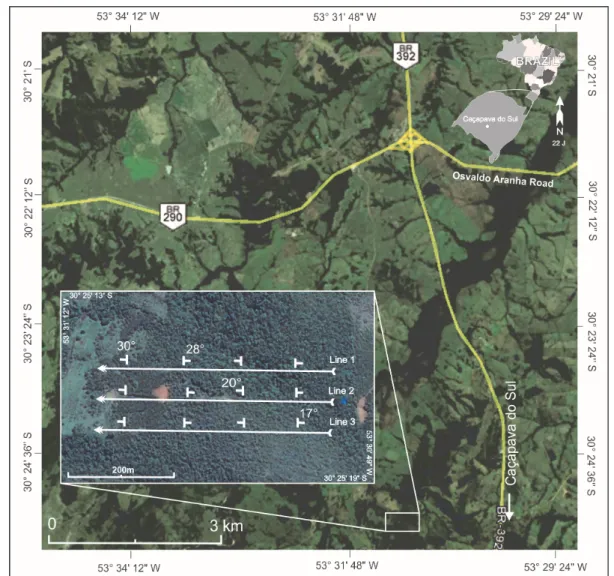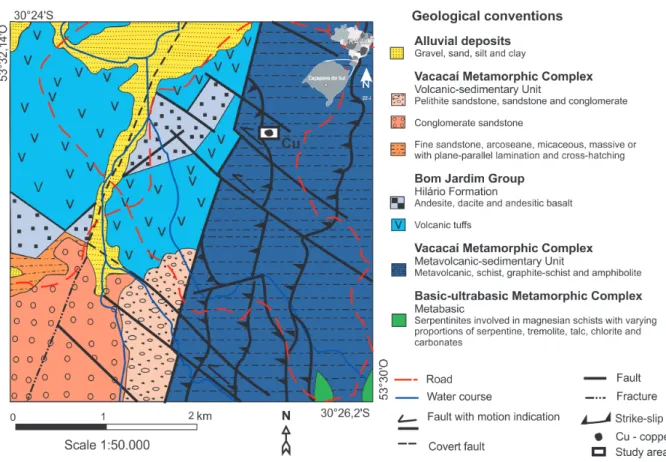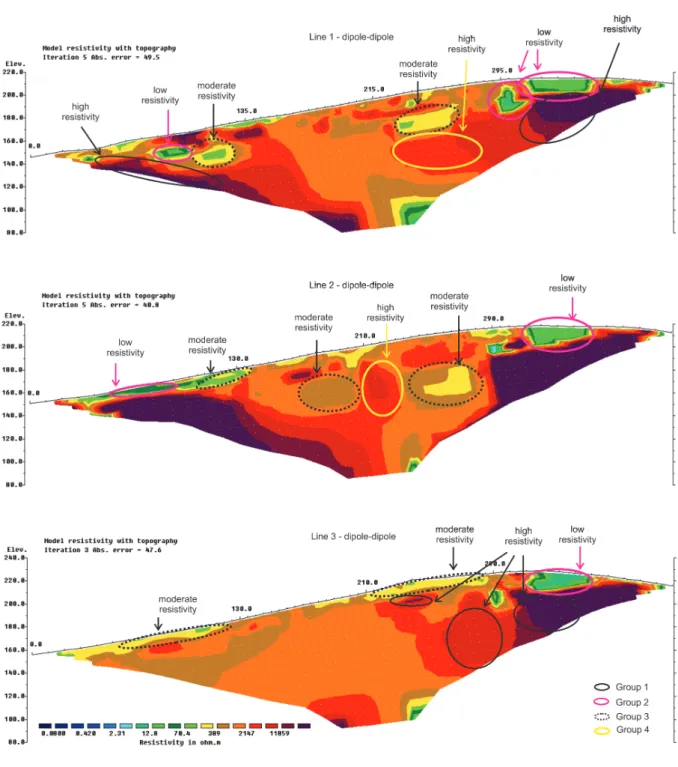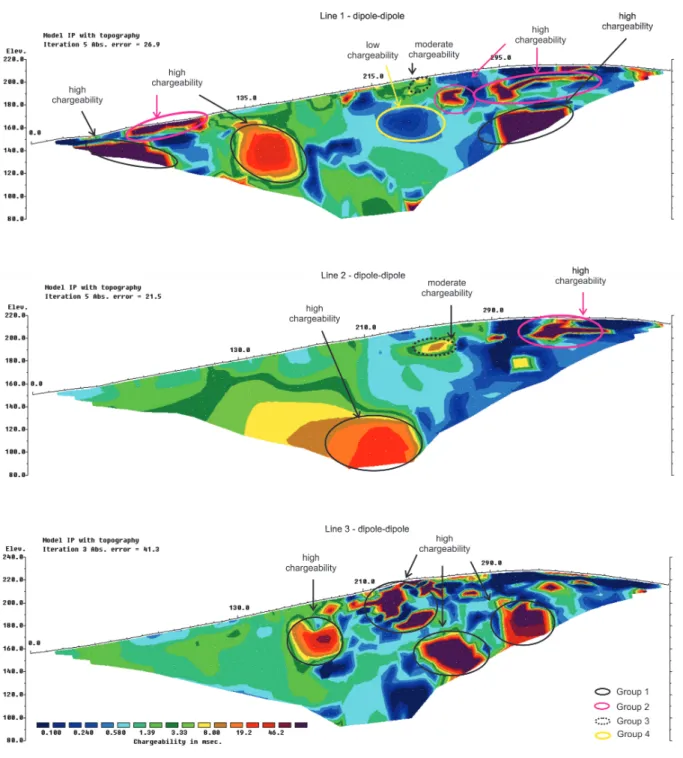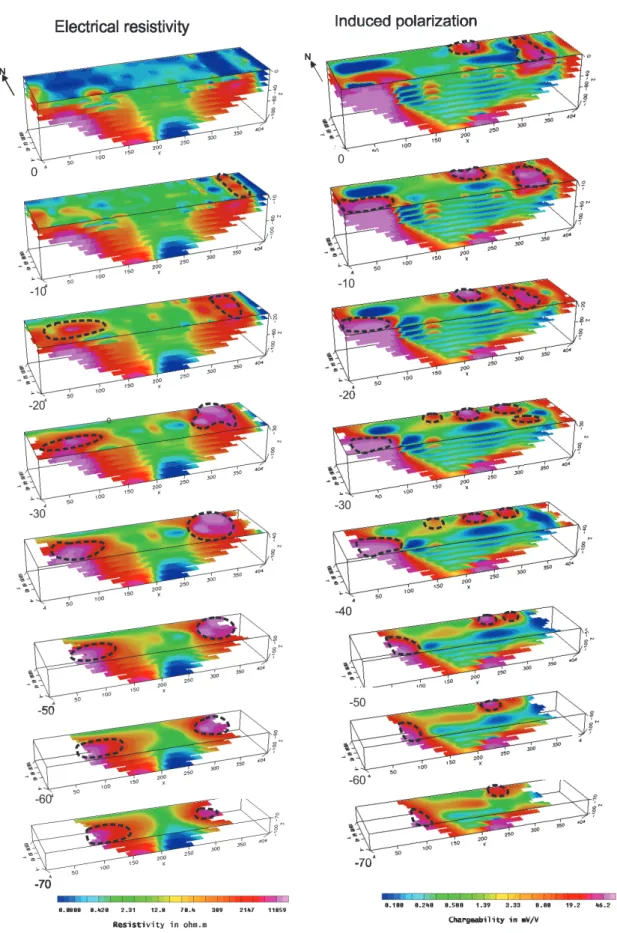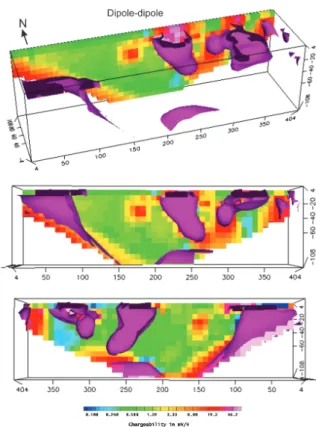www.scielo.br/rbg
GEOELECTRIC PROSPECTION OF COPPER OCCURRENCE IN FOLDED STRUCTURES
IN THE SUL-RIOGRANDENSE SHIELD (BRAZIL)
Shaiely Fernandes dos Santos
1, Cesar Augusto Moreira
2, Fernanda Teles Gomes Rosa
2,
Karolinny Borssatto
3and Marly Aparecida da Silva
3ABSTRACT.Sulfide prospecting with electrical resistivity and induced polarization geophysical methods are effective due to the contrast of electrical resistivity and chargeability disseminated sulfides or filonean deposits, which are characterized by low resistivity and high polarizability. This work carried out an electrical tomographic acquisition in a copper mineral occurrence, in the region of Caçapava do Sul, Rio Grande do Sul State, Brazil. Three lines were acquired using a dipole-dipole arrangement, with a length of 400 m and a spacing of 5 m between the electrodes. The lines were surveyed perpendicularly to a large anticlinal ridge, where carbonate and copper sulfides were recognized in a past mineral exploration galleries. The 2D inversion models and 3D multilevel maps indicate central and lateral regions with high resistivity and chargeability indicating the probable presence of copper sulfides, possibly in quartz veins. Peripheral zones with moderate resistivity and chargeability suggest zones of argilization; high chargeability and low resistivity are likely zones of sulfation; and high resistivity and low chargeability are possible zones of silicification.
Keywords: chargeability, mineral research, resistivity, sulfide, 3D multilevel modeling.
RESUMO.A prospecção de sulfetos por meio de métodos geofísicos de eletrorresistividade e polarização induzida são altamente efetivos devido ao contraste de resistividade elétrica e cargabilidade, uma vez que os depósitos com sulfetos disseminados ou filoneanos são caracterizados por baixa resistividade e alta polarizabilidade. Esse trabalho realizou aquisição de tomografia elétrica em ocorrência mineral de cobre, na região de Caçapava do Sul (RS). Foram realizadas 3 linhas de tomografia elétrica em arranjo dipolo-dipolo, com 400 m de comprimento e 5 m de espaçamento entre eletrodos, dispostas de forma perpendicular à crista de um anticlinal, onde no passado foram reconhecidos carbonatos e sulfetos de cobre, em galerias de exploração mineral. Os modelos de inversão 2D e mapas de multiníveis 3D indicam regiões centrais e laterais com alta resistividade e alta cargabilidade com provável zona de sulfetos alojados em veios de quartzo. Zonas periféricas com moderada resistividade e cargabilidade sugerem a presença de argilização; zonas com alta cargabilidade e baixa resistividade são prováveis zonas de sulfetação; e altos valores de resistividade e baixos de cargabilidade indicam zonas de silicificação.
Palavras-chave: cargabilidade, pesquisa mineral, resistividade elétrica, sulfeto, modelamento multinível 3D.
1Universidade Federal do Paraná - UFPR, Rua Reinaldo Stocco, 274, bloco 3 ap 1004, Pinheirinho, 81820-020 Curitiba, PR, Brazil - E-mail: fer.shay@gmail.com 2Universidade Estadual Paulista - UNESP, Applied Geology Department, Rio Claro Campus, Av. 24 A, 1515, Bela Vista, 13506-900 Rio Claro, SP, Brazil - E-mail:
moreirac@rc.unesp.br
3Universidade Estadual Paulista - UNESP, Institute of Geosciences and Exact Sciences, Rio Claro Campus, Av. 24 A, 1515, Bela Vista, 13506-900 Rio Claro, SP, Brazil - E-mails: fernandatgr1@gmail.com; karol-borssatto@hotmail.com; marliy.silva@yahoo.com
246
GEOELECTRIC PROSPECTION OF COPPER OCCURRENCE IN FOLDED STRUCTURES INTRODUCTIONThe great importance of copper ore in the world economy is maintaned for decades due to its physical and chemical properties that give it a wide range of uses in industrial technological development, such as in the electrical and electronics industry, industrial engineering, civil construction, transportation (automobile, naval, aeronautics and railway industries) among other uses (DNPM – Departamento Nacional de Produção Mineral, 2001).
Sulfide prospecting using geoelectric methods such as electrical resistivity and induced polarization (IP) are highly effective due to the contrast of electrical resistivity and chargeability, in disseminated sulfides or filonean deposits which are characterized by low resistivity and high polarizability (Moon et al., 2006; Kearey et al., 2013). Several geophysical methods show the applicability in the reconnaissance, delimitation and modelling of sulfide mineral occurrences, citing Irvine & Smith (1990), Locke et al. (1999), Allis (1990), Moreira & Ilha (2011), Moreira et al. (2012), Moreira et al. (2016b), (Moreira et al., 2016a), Agnoletto & Leite (2015), Gallas (2015), Côrtes et al. (2016), among others.
The measurement of electrical resistivity of soils and rocks is applicable to the identification of contrasts between lithologies and mineralized zones. The induced polarization method, in turn, measures the polarizability of geological materials. These methods were initially developed for the research of disseminated sulfides, where large-scale accumulation of electrical charges occurs in comparison to the geological materials that frequently make up soils and rocks, such as silicates and carbonates (Telford et al., 1990; Kearey et al., 2013).
This work aims to apply the electrical resistivity and induced polarization methods to characterize an occurrence of copper sulfide in the municipality of Caçapava do Sul, Rio Grande do Sul State (RS), southern Brazil.
LOCATION AND GEOLOGY
The study area is located northwest of the municipality of Caçapava do Sul (RS), distant 260 km from Porto Alegre. The region is historically known for its mining activity, dating back to the XIX century, mainly copper and gold up to the 1990s (Ronchi & Lobato, 2000) (Fig. 1).
The mineral occurrence is inserted in the Vacacaí Metamorphic Complex, close to the contact with the Camaquã Basin. This Metavolcanic-Sedimentary Unit consists of schists, graphite-schist, quartzite, amphibolite and intermediate
metavolcanic levels (CPRM – Serviço Geológico do Brasil, 2000) (Fig. 2).
The regional metamorphism that affected the rocks of this association is of low degree, with rocks of higher metamorphic degree in the vicinity of the Caçapava Granitic Complex, where there is mineral paragenesis of cornubianite hornblende, amphibolite and feldspatized amphibolites facies (CPRM – Serviço Geológico do Brasil, 1995).
The Caçapava do Sul Granite Complex consists of a domical structure elongated in the N/S direction, consisting of leucogranites, monzogranites, granodiorites and tonalites (Remus et al., 2000). The age and origin of the Caçapava granite is uncertain, however Rb/Sr isotopic data point to the crystallization ages of 552 ± 8 Ma (Gastal & Lafon, 1998).
The copper ore in the region of magmatic hydrothermal prigin, according to Teixeira (1937), Leinz & Almeida (1941), Bettencourt (1972), Beckel (1990), Remus et al. (2000) being found as veins and filling fractures that cause changes in the hosting rock, such as silicification, carbonation, argilization and dissemination. The rise of hydrothermal fluids from deep magmatic bodies through fractures originated the ores explored in the Camaquã mines, explored since the XIX century and which served as a basis for proposing the main genetic models for metalic deposits in the Camaquã sedimentary basin (Bettencourt, 1972; Remus et al., 2000).
The copper mineral occurrence in the study area is nested on the crest of a fold, deforming alternating schists and quartzites, where mineralized copper veins were explored in the 1950s from galleries and trenches. The recognized minerals consist of copper carbonates (malachite and azurite), besides copper and iron sulfides (cuprite, chalcopyrite, covelite, chalcocite and pyrite), mainly found in mining exploration research galleries.
MATERIALS AND METHODS
DC Resistivity and Induced Polarization methods were used applying the electrical tomography technique in a dipole-dipole arrangement. Such electrode arrangement was chosen because it is more effective in delineating contrasting features amid zones of inclined and fractured folds than the other arrangements.
Three parallel lines, spaced of 50 m in a E-W direction, were surveyed adopting 5 m spacing between electrodes (Fig. 1). A structural analysis of 200 compass measurements of fractures and foliation orientation was conducted to help in the location of the survey lines perpendicular to the general orientation of the fold axis (N-S) (Fig. 1). We used a Terrameter LS resistivity
Figure 1 – Location of the study area and positioning of electrical tomography lines and foliation measurements.
meter, manufactured by ABEM - Instrument, configuring the parameters for reading the induced polarization to 400 mA, 1.5s time transmission, current cut-off after 0.3s in two consecutive reading windows of 0.1s.
The data were processed in the RES2DINV program developed by Geotomo Software, which determines a two-dimensional (2D) section model of the subsurface, of the resistivity and chargeability in terms of distance x depth (Loke & Barker, 1996).
The numerical product of the 2D inversion of each section was gathered into a single worksheet, which records the position of the readings along the lines (variable x), spacing among lines (variable y), depth modeled by the inversion (variable z), and the value of the geophysical parameter (resistivity/chargeability
variable). This worksheet is used to generated the 3D models, transfered to the Oasis Montaj software.
RESULTS AND DISCUSSIONS
The 200 structural measurements in field work indicated two families of fractures, heading N39/47W, N54/62W and with bedding to NE. Based on such structural framework, it was suggested the acquisition of data in the E/W direction.
In Figure 3, the resistivity inversion models for lines 1, 2 and 3 represent the resistivity values in relation to topographic elevation and the distance from the beginning of the survey lines. The induced polarization method resulted in version models for chargeability, presented on Figure 4. The maximum and minimum
248
GEOELECTRIC PROSPECTION OF COPPER OCCURRENCE IN FOLDED STRUCTURESFigure 2 – Geological map of the study area. Source: Passo do Salsinho map SH-22-Y-A-I-4, CPRM – Serviço Geológico do Brasil (1995).
values of resistivity and chargeability are around 2147 Ω.m and 12.8 Ω.m, and 46.2 mV/V and 0.24 mV/V, respectively.
The lateral and vertical changes in resistivity and chargeability are related to lithology and structural features. During metamorphism significant physical changes in the host rock due to hydrothermal activities result in anomalies and the fluids migrate to lower pressure zones, usually at the crest of folds. The mineralized veins and lodes are always surrounded by a well-developed hydrothermal alteration halo, usually proportional to the size of the lodes. (Allis, 1990; Biondi, 2003; Robb, 2005).
The mineralized structures can be characterized by contrasts in geoelectric parameters. Dissolved sulfide zones react as capacitors, which accumulate the charge of the applied electric current, thus causing the effect of the induced polarization. The zones with high silica concentration present a dielectric behavior, which hinders the passage of electric current, where the resistance effect occurs. Therefore, based on these physical concepts and in the local geology, it is possible to interpret the zones of chargeability and resistivity.
The identification of potential zones for sulfide accumulation is based on ranges of resistivity and chargeability values, physical parameters directly influenced by the presence of disseminated sulfides. Based on these parameters, we recognized the following 4 groups: Group 1 with high resistivity values (≥ 2147 Ω.m) and peaks of chargeability (≥ 19.2 mV/V); Group 2 with low resistivity values (≤ 12.8 Ω.m) and peaks of chargeability (≥ 19.2 mV/V); Group 3 with moderate values of chargeability (≥ 8 mV/V) and resistivity (≥ 389 Ω.m); Group 4 with high resistivity values (≥ 2147 Ω.m) and low chargeability (≤ 3.3 mV/V) (Figs. 3 and 4).
Group 1 indicates regions with sulfide and quartz concentration. The geological descriptions of field outcrops allowed the recognition of fractured quartzites predominantly. This set of factors justifies the occurrence of stockwork-type sulfide mineralization, characterized by a concentrated mesh of fractures filled by an association of quartz and sulfides (Biondi, 2003). In this sense, the high values of chargeability associated to a conductive zone indicate the occurrence of a zone of sulfation,
250
GEOELECTRIC PROSPECTION OF COPPER OCCURRENCE IN FOLDED STRUCTURES252
GEOELECTRIC PROSPECTION OF COPPER OCCURRENCE IN FOLDED STRUCTUREScomposed by disseminated copper sulfides. This zone has the highest potential for copper sulfides in the area.
Group 2 indicates the presence of sulfides and a probable sulfation zone in schist, commonly described in a large variety of hydrothermal metallic deposits (Robb, 2005). The areas of high chargeability present values equivalent to sulfide zones described in surface (Group 1). The areas of low resistivity in this group can be attributed to at least two factors: chloritization and sericitization of schist by hydrothermal processes, accompanied by chemical changes and the genesis of sulfide mineralizations. This zone also presents potential for high levels of copper sulfides in the area.
Group 3 indicates the presence of sulfides, at lower concentrations, and may be related to possible areas of schist argilization. Zone of argillic alteration is characterized by the formation of clay minerals due to acid leaching, originating from the process of percolation of hydrothermal fluid in the schist. Typically metassomatism occurs under temperatures below 250◦
C, presenting an extreme form of leaching where several alkaline elements are removed from the embedding rock by acidic fluids (Pirajno, 1992).
Group 4 indicates areas with low sulfide content, inferred as possible zones of silicification. The cementation of the rock by quartz, during the hydrothermal processes, results in the decrease of the porosity and in the consequent increase of the resistivity (Robb, 2005). In this context, resistive areas with low values of chargeability are indicative of zones of silicification peripheral to the zones of sulfation.
The integration and interpolation of the inversion models allowed the generation of 3D or quasi 3D visualization models. Subsequent processing allowed the generation of physical parameter maps for different levels of depth, separated every 10 m (Fig. 5).
The multilevel resistivity maps show important features between 10 m and 70 m depth. These features are observed at a distance of 100 m and in the final region from 270 m, ranging from 389 Ω.m to 2147 Ω.m. Multilevel chargeability maps show significant features from 300 m to a depth of 70 m, with values greater than 19 mV/V. In the central region, between distances of 200 and 300 m, high chargeability zones are also observed in the direction from line 2 to line 3, which can be correlated with the circular features of line 3 in the 2D inversion model and high values in the initial portion of the section (Fig. 5).
In this set of data, it is possible to observe two relevant features, both for resistivity and for chargeability. These features located in the initial and final portions of the section present
elongated shapes and distinct directions, one N-S and another E-W. Both are characterized by high chargeability and resistivity, which resumes the possible occurrence of sulfide mineralizations of the stockwork-type presented in Group 1 (Fig. 5).
In the chargeability model, it is possible to notice that these high values are located between 0 and 30 m depth, and when compared with the resistivity model the high values remain up to 70 m depth. Therefore, it is possible to observe elements of Group 4 from the level of 40 meters depth.
In the 3D isosurface model for the dipole-dipole arrangement, it is possible to observe an inclined geometry structure of high chargeability, 30 mV/V, located in the central portion of the model. This volume of high chargeability may reflect a mineralized sulfide zone, showing low resistivity values, characteristics that allow it to be associated to a probable zone of sulfation. It is also possible to notice a second high chargeability body in the final portion of the model, characterized by high resistivity probably associated with a probable sulfide stockwork-type accumulation (Fig. 6).
Figure 6 – 3D isosurface model with chargeability parameter to dipole-dipole
CONCLUSIONS
In spite of the geological and structural complexity of the study area, the results allowed the recognition geophysical signatures compatible with structurally controlled sulfide mineral accumulations, based on evidence of mineralization described in the field and in a review of geophysical prospection studies for similar mineral occurrences.
The 2D inversion models present circular areas of moderate to high intensity, both for resistivity and chargeability, related to probable mineralizations. This response is related to the conductive and polarizable behavior of the sulfides and to the insulating behavior of the quartz veins.
Thus, the induced polarization method demonstrated satisfactory results in the characterization of copper occurrences, since it allowed verifying the lateral continuity and the depth of the zones with sulfide concentration due to the contrast of the physical properties between the nesting rocks and the mineralized zones. The results also allowed to establish that the most promising mineralization areas occur between 0 m and 80 m.
Thus, in view of the concentration of sulfides in areas of high chargeability and high resistivity (Group 1) and high chargeability and low resistivity (Group 2), direct research is recommended via targeted guided survey, with the objective of verifying contents and economic viability of the occurrence.
The existence of mineralizations in the form of individualized and independent bodies makes detection by direct investigation (probes) something extremely difficult, with high cost and low degree of success. In this sense, the results of this study also show the possibility of using geoelectric methods in the definition of targets for probing in geological conditions of high complexity.
ACKNOWLEDGMENTS
The authors are thankful to Coordenação de Aperfeiçoamento de Pessoal de Nível Superior (CAPES) for the financial support.
REFERENCES
AGNOLETTO E & LEITE EP. 2015. Identification of exploration gold targets in the Alta Floresta Gold Province, Mato Grosso state, Brazil, based on an integrated interpretation of magnetic and geochemical data. Brazilian Journal of Geophysics, 33(2): 305–318.
ALLIS R. 1990. Geophysical anomalies over epithermal systems. Journal of Geochemical Exploration, 36(1-3): 339–374.
BECKEL J. 1990. Metalogenía del Cu, Pb y Zn en la Cuenca de Camaquã durante el ciclo orogênico Brasiliano, RS (Brasil). Ph.D. thesis. Universidad de Salamanca, Spain, 275 pp.
BETTENCOURT JS. 1972. Mina de Cobre de Camaquã, Rio Grande do Sul. Ph.D. thesis. Universidade de São Paulo, Brazil. 175 pp. BIONDI JC. 2003. Processos metalogenéticos e os depósitos minerais brasileiros. Volume 1. São Paulo: Oficina de Textos. 528 pp.
CÔRTES AR, MOREIRA CA, VELOSO DI, VIEIRA LB & BERGONZONI FA. 2016. Geoelectrical prospecting for a copper-sulfide mineralization in the Camaquã sedimentary basin, Southern Brazil. Geofísica Internacional, 55(3): 165–174.
CPRM – Serviço Geológico do Brasil. 1995. Passo do Salsinho. Folha SH-22-Y-A-I-4, Estado do Rio Grande do Sul, Escala 1:50.000. Programa Levantamentos Geológicos do Brasil. Brasília, Brazil. CPRM – Serviço Geológico do Brasil. 2000. Mapa geológico do estado do Rio Grande do Sul. Brazil.
DNPM – Departamento Nacional de Produção Mineral. 2001. Balanço Mineral Brasileiro. Brazil.
GALLAS JDF. 2015. Quartz prospecting with induced polarization (IP) and resistivity by using gradient and dipole-dipole arrays. Brazilian Journal of Geophysics, 33(4): 555–564.
GASTAL MDCP & LAFON JM. 1998. Gênese e evolução dos granitóides metaluminosos de afinidade alcalina da porção oeste do escudo Sul-riograndense: Geoquímica e isótopos de Rb-Sr e Pb-Pb. Revista Brasileira de Geociências, 28(1): 11–28.
IRVINE R & SMITH M. 1990. Geophysical exploration for epithermal gold deposits. Journal of Geochemical Exploration, 36(1-3): 375–412. KEAREY P, BROOKS M & HILL I. 2013. An introduction to geophysical exploration. London: Blackwell Science. 3rd., 281 pp.
LEINZ V & ALMEIDA SC. 1941. Gênese da jazida de cobre “Camaquã”, município de Caçapava – Rio Grande do Sul. Porto Alegre, Secretaria dos Negócios de Agricultura, Indústria e Comércio do Estado do Rio Grande do Sul, Brazil, DPM, Boletim n.88, 56 pp.
LOCKE CA, JOHNSON SA, CASSIDY J & MAUK JL. 1999. Geophysical exploration of the Puhipuhi epithermal area, Northland, New Zealand. Journal of Geochemical Exploration, 65(2): 91–109.
LOKE MH & BARKER RD. 1996. Rapid least-squares inversion of apparent resistivity pseudosections by a quasi-Newton method. Geophysical Prospecting, 44(1): 131–152.
MOON CJ, WHATELEY MEG & EVANS AM. 2006. Introduction to mineral exploration. Blackwell Publishing, Oxford. 2 ed., 499 pp.
MOREIRA CA & ILHA LM. 2011. Prospecção geofísica em ocorrência de cobre localizada na bacia sedimentar do Camaquã (RS). Rem: Revista Escola de Minas, 64(3): 305–311.
254
GEOELECTRIC PROSPECTION OF COPPER OCCURRENCE IN FOLDED STRUCTURESMOREIRA CA, LOPES SM, SCHWEIG C & DA ROSA SEIXAS A. 2012. Geoelectrical prospection of disseminated sulfide mineral occurrences in Camaquã sedimentary basin, Rio Grande do Sul state, Brazil. Brazilian Journal of Geophysics, 30(2): 169–179.
MOREIRA CA, BORSSATTO K, ILHA LM, SANTOS SFD & ROSA FTG. 2016a. Geophysical modeling in gold deposit through DC Resistivity and Induced Polarization methods. REM-International Engineering Journal, 69(3): 293–299.
MOREIRA CA, REIS SS, MALAGUTTI FILHO W & HANSEN MAF. 2016b. Geoelectric modeling of supergenic manganese occurrence in Heliodora region, southern Minas Gerais. Brazilian Journal of Geophysics, 34(3): 299–308.
PIRAJNO F. 1992. Hydrothermal mineral deposits: principles and fundamental concepts for the exploration geologist. Berlin: Springer-Verlag. 709 pp.
REMUS MVD, HARTMANN LA, McNAUGHTON NJ, GROVES DI & REISCHL J. 2000. Distal magmatic-hydrothermal origin for the Camaquã Cu (Au-Ag) and Santa Maria Pb, Zn (Cu-Ag) deposits, southern Brazil. Gondwana Research, 3(2): 155–174.
ROBB L. 2005. Introduction to ore-forming processes. Oxford: Blackwell. 386 pp.
RONCHI LH & LOBATO AOC. 2000. Minas do Camaquã: um estudo multidisciplinar. São Leopoldo: Unissinos. 366 pp.
TEIXEIRA E. 1937. DNPM. O Cobre no Rio Grande do Sul. Boletim da Divisão de Fomento a Produção Mineral. DNPM, Brazil, 29 pp. TELFORD WM, TELFORD W & GELDART L. 1990. Applied Geophysics. Volume 1. Cambridge University Press. 770 pp.
Recebido em 16 janeiro, 2018 / Aceito em 16 outubro, 2018 Received on January 16, 2018 / accepted on October 16, 2018
